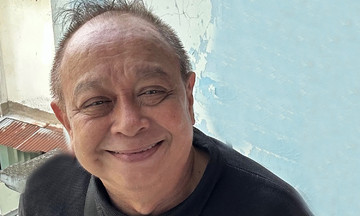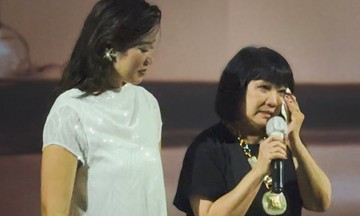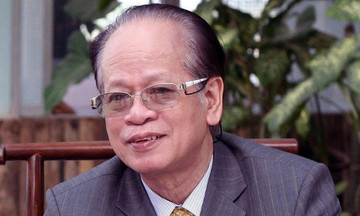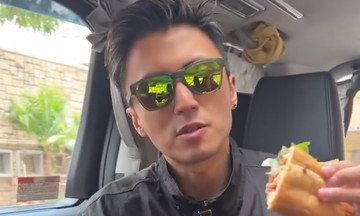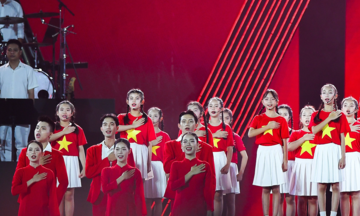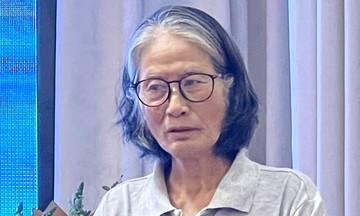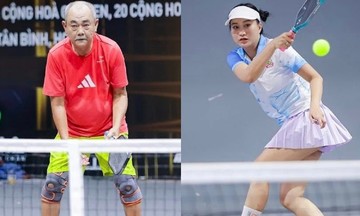According to The Paper, both artist Pham Tang and his wife, Tu Manh, have remained silent regarding Pham Tang's daughter's allegations of "abduction and property seizure." The incident sparked public controversy last week.
Art collector Tao Trach Ich, a close friend of Pham Tang, visited the artist on 4/8 and reported him to be in good health and spirits, contradicting his daughter Pham Hieu Hue's claim that he had been "missing since 13/7."
 |
Pham Tang and his fourth wife, Tu Manh. Photo: Red Note |
Pham Tang and his fourth wife, Tu Manh. Photo: Red Note
Tao Trach Ich explained that the couple moved from their Bich Thuy Trang villa (outside Beijing) to fulfill Pham Tang's promise to buy Tu Manh a new home after their 2024 marriage. They relocated after over a year of design work.
Another friend of the artist confirmed he is "fine, just staying home writing a book." Pham Tang expressed gratitude for the concern but declined further comment on family matters.
Tao Trach Ich stated that Pham Tang and Tu Manh are legally married, giving Tu Manh the right to manage joint marital assets. He suggested that Pham Hieu Hue should seek legal recourse if she believes her inheritance rights have been violated.
Some Beijing art investors have described the situation as a "family feud." On 16/7, Pham Hieu Hue posted on social media expressing "deep concern for her father's safety." She alleged that Tu Manh moved her father out of their villa and then transported valuable antiques and paintings elsewhere, effectively seizing his assets.
Pham Tang has had a complex personal life, with four marriages. His first marriage, in 1963, was to the poet and calligrapher Lam Tu. Despite initial admiration, the relationship was fraught with arguments, leading to divorce after five years.
In 1971, he married Bien Bao Hoa, a former classmate who had long admired him but remained silent due to his relationship with Lam Tu. Bien Bao Hoa had also married and divorced due to her husband's infidelity. Upon learning of Pham Tang's divorce, she expressed her feelings, and they began a relationship, resulting in a daughter, Pham Hieu Hue, his only biological child.
In the 1970s, during a period of career stagnation, Pham Tang received financial support from a friend, Tu Ton Duc. During a dinner invitation, Pham Tang became enamored with Tu Ton Duc's wife, Truong Que Van.
According to Ifeng, Pham Tang admitted in his autobiography to being captivated by Que Van's beauty, a mother of three at the time. He wrote, "She wore a white dress, with two jet-black braids, simple yet incredibly elegant." This encounter significantly altered the lives of those involved.
Pham Tang and Truong Que Van carried on a secret affair for over 10 years. He would visit her whenever Tu Ton Duc was away, climbing 14 flights of stairs to avoid detection in the elevator.
While maintaining this clandestine relationship, Pham Tang remained friends with Tu Ton Duc. In 1977, when Pham Tang was hospitalized, Tu Ton Duc and Truong Que Van visited him weekly. He wrote, "Every time Que Van visited, I felt better. She awakened spring within me."
In 1988, Que Van confessed her love for Pham Tang to her husband. Tu Ton Duc agreed to a divorce and moved from Beijing to Shanghai. Que Van's three children from her previous marriage stayed with her and Pham Tang, taking his surname.
Pham Hieu Hue was initially angry with her father and ceased contact, but they later reconciled. Tu Ton Duc criticized Pham Tang for "betraying his kindness and seducing his wife." Pham Tang faced public condemnation for his actions.
Tu Manh with her husband while he was working in 2024. Video: Red Note
After his third marriage, Pham Tang avoided further romantic scandals. Truong Que Van passed away in 2021, leaving him despondent. Tu Manh's arrival reportedly revived his spirits.
Pham Tang is a prominent figure in contemporary Chinese art. According to National Business Daily, he is the "most expensive" living Chinese artist, with numerous works fetching high prices at auction. By 2024, his total auction sales exceeded 2.3 billion CNY (320 million USD).
His works are displayed in museums internationally, including Japan and the UK. Several pieces have achieved remarkable auction prices, such as "Truc Thuoc" (over 40 million CNY/ 5.1 million USD) and "Linh Tuyen Dao Phong" (18.4 million CNY/ 2.5 million USD), with dozens of others exceeding one million USD.
Nhu Anh (according to The Paper, Ifeng)




